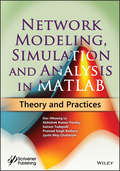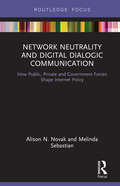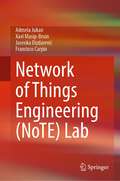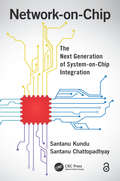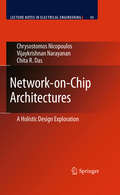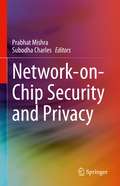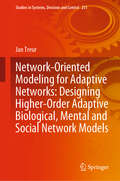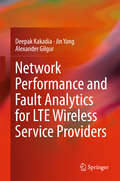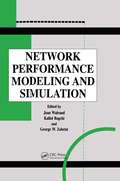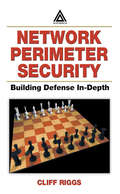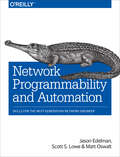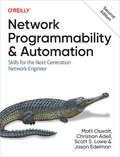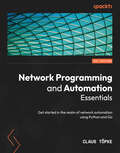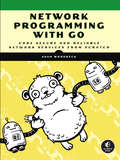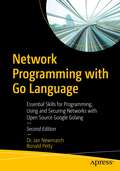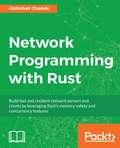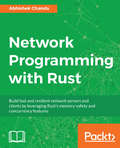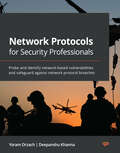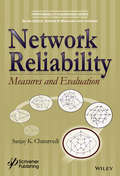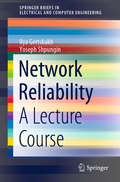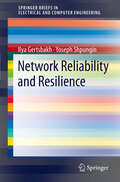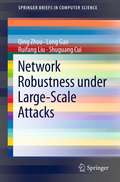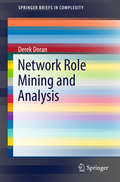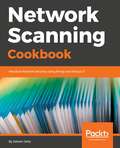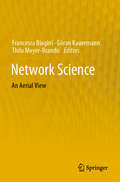- Table View
- List View
Network Modeling, Simulation and Analysis in MATLAB: Theory and Practices
by Dac-Nhuong Le Abhishek Kumar Pandey Sairam Tadepalli Pramod Singh Rathore Jyotir Moy ChatterjeeThe purpose of this book is first to study MATLAB programming concepts, then the basic concepts of modeling and simulation analysis, particularly focus on digital communication simulation. The book will cover the topics practically to describe network routing simulation using MATLAB tool. It will cover the dimensions’ like Wireless network and WSN simulation using MATLAB, then depict the modeling and simulation of vehicles power network in detail along with considering different case studies. Key features of the book include: Discusses different basics and advanced methodology with their fundamental concepts of exploration and exploitation in NETWORK SIMULATION. Elaborates practice questions and simulations in MATLAB Student-friendly and Concise Useful for UG and PG level research scholar Aimed at Practical approach for network simulation with more programs with step by step comments. Based on the Latest technologies, coverage of wireless simulation and WSN concepts and implementations
Network Neutrality and Digital Dialogic Communication: How Public, Private and Government Forces Shape Internet Policy (Routledge Studies in Media Law and Policy)
by Alison N. Novak Melinda SebastianIn the months after the Federal Communications Commission’s (FCC) 2017 decision to repeal network neutrality as US policy, it is easy to forget the decades of public, organizational, media and governmental struggle to control digital policy and open access to the internet. Using dialogic communication tactics, the public, governmental actors and organizations impacted the ruling through YouTube comments, the FCC online system and social network communities. Network neutrality, which requires that all digital sites can be accessed with equal speed and ability, is an important example of how dialogic communication facilitates public engagement in policy debates. However, the practice and ability of the public, organizations and media to engage in dialogic communication are also greatly impacted by the FCC’s decision. This book reflects on decades of global engagement in the network neutrality debate and the evolution of dialogic communication techniques used to shape one of the most relevant and critical digital policies in history.
Network of Things Engineering (NoTE) Lab
by Admela Jukan Xavi Masip-Bruin Jasenka Dizdarević Francisco CarpioThis book provides a hands-on experience in software and hardware engineering of IoT devices in edge and cloud computing systems, by putting in practice state-of-the-art concepts of hardware devices, networking and computing software. It proposes a Network of Things Engineering (NoTE) Lab, with seven hands-on lab modules covering topics ranging from “Interfacing sensors and actuators” and “Connecting IoT and Edge with MQTT" to “Data pipelining in cloud computing”. All tools and software used in the NoTE Lab are free and open source, and available to the readers. Specifically, Arduino-based boards that support a variety of low-cost sensors and actuators are used in IoT context. In edge computing, NoTE Lab implements off-the-shelf single board computers, Raspberry Pis with corresponding software and hardware. For cloud, well-known and widely used cloud computing open-source tools (e.g., Kubernetes) are deployed, where readers can learn the basics of monitoring and managing containers in cloud computing. Three communication protocols are used in the end-to-end setup, including MQTT, AMQP and HTTP. This lab book is a "must experiment with" for anybody in academia and industry participating in the fascinating IoT-edge-cloud continuum development.
Network-on-Chip: The Next Generation of System-on-Chip Integration
by Santanu Kundu Santanu ChattopadhyayAddresses the Challenges Associated with System-on-Chip Integration Network-on-Chip: The Next Generation of System-on-Chip Integration examines the current issues restricting chip-on-chip communication efficiency, and explores Network-on-chip (NoC), a promising alternative that equips designers with the capability to produce a scalable, reusable, and high-performance communication backbone by allowing for the integration of a large number of cores on a single system-on-chip (SoC). This book provides a basic overview of topics associated with NoC-based design: communication infrastructure design, communication methodology, evaluation framework, and mapping of applications onto NoC. It details the design and evaluation of different proposed NoC structures, low-power techniques, signal integrity and reliability issues, application mapping, testing, and future trends. Utilizing examples of chips that have been implemented in industry and academia, this text presents the full architectural design of components verified through implementation in industrial CAD tools. It describes NoC research and developments, incorporates theoretical proofs strengthening the analysis procedures, and includes algorithms used in NoC design and synthesis. In addition, it considers other upcoming NoC issues, such as low-power NoC design, signal integrity issues, NoC testing, reconfiguration, synthesis, and 3-D NoC design. This text comprises 12 chapters and covers: The evolution of NoC from SoC—its research and developmental challenges NoC protocols, elaborating flow control, available network topologies, routing mechanisms, fault tolerance, quality-of-service support, and the design of network interfaces The router design strategies followed in NoCs The evaluation mechanism of NoC architectures The application mapping strategies followed in NoCs Low-power design techniques specifically followed in NoCs The signal integrity and reliability issues of NoC The details of NoC testing strategies reported so far The problem of synthesizing application-specific NoCs Reconfigurable NoC design issues Direction of future research and development in the field of NoC Network-on-Chip: The Next Generation of System-on-Chip Integration covers the basic topics, technology, and future trends relevant to NoC-based design, and can be used by engineers, students, and researchers and other industry professionals interested in computer architecture, embedded systems, and parallel/distributed systems.
Network-on-Chip Architectures
by Chita R. Das Vijaykrishnan Narayanan Chrysostomos NicopoulosThe continuing reduction of feature sizes into the nanoscale regime has led to dramatic increases in transistor densities. Integration at these levels has highlighted the criticality of the on-chip interconnects. Network-on-Chip (NoC) architectures are viewed as a possible solution to burgeoning global wiring delays in many-core chips, and have recently crystallized into a significant research domain. On-chip networks instill a new flavor to communication research due to their inherently resource-constrained nature. Despite the lightweight character demanded of the NoC components, modern designs require ultra-low communication latencies in order to cope with inflating data bandwidths. The work presented in Network-on-Chip Architectures addresses these issues through a comprehensive exploration of the design space. The design aspects of the NoC are viewed through a penta-faceted prism encompassing five major issues: (1) performance, (2) silicon area consumption, (3) power/energy efficiency, (4) reliability, and (5) variability. These five aspects serve as the fundamental design drivers and critical evaluation metrics in the quest for efficient NoC implementations. The research exploration employs a two-pronged approach: (a) MICRO-architectural innovations within the major NoC components, and (b) MACRO-architectural choices aiming to seamlessly merge the interconnection backbone with the remaining system modules. These two research threads and the aforementioned five key metrics mount a holistic and in-depth attack on most issues surrounding the design of NoCs in multi-core architectures.
Network-on-Chip Security and Privacy
by Prabhat Mishra Subodha CharlesThis book provides comprehensive coverage of Network-on-Chip (NoC) security vulnerabilities and state-of-the-art countermeasures, with contributions from System-on-Chip (SoC) designers, academic researchers and hardware security experts. Readers will gain a clear understanding of the existing security solutions for on-chip communication architectures and how they can be utilized effectively to design secure and trustworthy systems.
Network-Oriented Modeling for Adaptive Networks: Designing Higher-Order Adaptive Biological, Mental and Social Network Models (Studies in Systems, Decision and Control #251)
by Jan TreurThis book addresses the challenging topic of modeling adaptive networks, which often manifest inherently complex behavior. Networks by themselves can usually be modeled using a neat, declarative, and conceptually transparent Network-Oriented Modeling approach. In contrast, adaptive networks are networks that change their structure; for example, connections in Mental Networks usually change due to learning, while connections in Social Networks change due to various social dynamics. For adaptive networks, separate procedural specifications are often added for the adaptation process. Accordingly, modelers have to deal with a less transparent, hybrid specification, part of which is often more at a programming level than at a modeling level. This book presents an overall Network-Oriented Modeling approach that makes designing adaptive network models much easier, because the adaptation process, too, is modeled in a neat, declarative, and conceptually transparent Network-Oriented Modeling manner, like the network itself. Thanks to this approach, no procedural, algorithmic, or programming skills are needed to design complex adaptive network models. A dedicated software environment is available to run these adaptive network models from their high-level specifications. Moreover, because adaptive networks are described in a network format as well, the approach can simply be applied iteratively, so that higher-order adaptive networks in which network adaptation itself is adaptive (second-order adaptation), too can be modeled just as easily. For example, this can be applied to model metaplasticity in cognitive neuroscience, or second-order adaptation in biological and social contexts. The book illustrates the usefulness of this approach via numerous examples of complex (higher-order) adaptive network models for a wide variety of biological, mental, and social processes. The book is suitable for multidisciplinary Master’s and Ph.D. students without assuming much prior knowledge, although also some elementary mathematical analysis is involved. Given the detailed information provided, it can be used as an introduction to Network-Oriented Modeling for adaptive networks. The material is ideally suited for teaching undergraduate and graduate students with multidisciplinary backgrounds or interests. Lecturers will find additional material such as slides, assignments, and software.
Network Performance and Fault Analytics for LTE Wireless Service Providers
by Deepak Kakadia Jin Yang Alexander GilgurThis book is intended to describe how to leverage emerging technologies big data analytics and SDN, to address challenges specific to LTE and IP network performance and fault management data in order to more efficiently manage and operate an LTE wireless networks. The proposed integrated solutions permit the LTE network service provider to operate entire integrated network, from RAN to Core , from UE to application service, as one unified system and correspondingly collect and align disparate key metrics and data, using an integrated and holistic approach to network analysis. The LTE wireless network performance and fault involves the network performance and management of network elements in EUTRAN, EPC and IP transport components, not only as individual components, but also as nuances of inter-working of these components. The key metrics for EUTRAN include radio access network accessibility, retainability, integrity, availability and mobility. The key metrics for EPC include MME accessibility, mobility and capacity, SGW, PGW capacity and connectivity. In the first parts of the book, the authors describe fundamental analytics techniques, and various key network partitions - RAN, Backhaul, Metro and Core of a typical LTE Wireless Service Provider Network. The second part of the book develops more advanced analytic techniques that can be used to solve complex wireless network problems. The second part of this book also describes practical and novel solutions for LTE service network performance and fault management systems using big data engineering. Self-organizing network (SON) architecture is presented as a way to utilize network performance and fault analytics to enable network automation. SON can significantly improve operational efficiencies and speed up network deployment. This book provides various ways to leverage data science to more intelligently and reliably to automate and manage a wireless network. The contents of the book should be useful to professional engineers and networking experts involved in LTE network operations and management. The content will also be of interest to researchers, academic and corporate, interested in the developments in fault analytics in LTE networks.
Network Performance Modeling and Simulation
by Jean Walrand Kallol Bagchi George W. ZobristThis book makes the argument that performance modeling and simulation have become central issues in computer science and engineering, in part due to applications to the structures comprising the Internet. Dealing primarily with theory, tools and techniques as related to communications systems, the volume provides tutorials and surveys and relates new important research results. Each chapter presents background information, describes and analyzes important work done in the field and provides direction to the reader on future work and further readings. The topics covered include traffic models for A TM networks, simulation environments, analytical methods, interprocessor communications, and an evaluation of process architectures.
Network Perimeter Security: Building Defense In-Depth
by Cliff RiggsToday's network administrators are fully aware of the importance of security; unfortunately, they have neither the time nor the resources to be full-time InfoSec experts. Oftentimes quick, temporary security fixes are the most that can be expected. The majority of security books on the market are also of little help. They are either targeted toward
Network Programmability and Automation: Skills for the Next-Generation Network Engineer
by Jason Edelman Scott S. Lowe Matt OswaltLike sysadmins before them, network engineers are finding that they cannot do their work manually anymore. As the field faces new protocols, technologies, delivery models, and a pressing need for businesses to be more agile and flexible, network automation is becoming essential. This practical guide shows network engineers how to use a range of technologies and tools—including Linux, Python, JSON, and XML—to automate their systems through code.Network programming and automation will help you simplify tasks involved in configuring, managing, and operating network equipment, topologies, services, and connectivity. Through the course of the book, you’ll learn the basic skills and tools you need to make this critical transition.This book covers:Python programming basics: data types, conditionals, loops, functions, classes, and modulesLinux fundamentals to provide the foundation you need on your network automation journeyData formats and models: JSON, XML, YAML, and YANG for networkingJinja templating and its applicability for creating network device configurationsThe role of application programming interfaces (APIs) in network automationSource control with Git to manage code changes during the automation processHow Ansible, Salt, and StackStorm open source automation tools can be used to automate network devicesKey tools and technologies required for a Continuous Integration (CI) pipeline in network operations
Network Programmability and Automation
by Jason Edelman Scott S. Lowe Matt Oswalt Christian AdellNetwork engineers are finding it harder than ever to rely solely on manual processes to get their jobs done. New protocols, technologies, delivery models, and the need for businesses to become more agile and flexible have made network automation essential. The updated second edition of this practical guide shows network engineers how to use a range of technologies and tools, including Linux, Python, APIs, and Git, to automate systems through code. This edition also includes brand new topics such as network development environments, cloud, programming with Go, and a reference network automation architecture.Network Programmability and Automation will help you automate tasks involved in configuring, managing, and operating network equipment, topologies, services, and connectivity. Through the course of the book, you'll learn the basic skills and tools you need to make this critical transition.You'll learn:Programming skills with Python and Go: data types, conditionals, loops, functions, and moreHow to work with Linux-based systems, the foundation for modern networking and cloud platformsData formats and models: JSON, XML, YAML, and YANGJinja templating for creating network device configurationsThe role of application programming interfaces (APIs) in network automationSource control with Git to manage code changes during the automation processCloud-native technologies like Docker and KubernetesHow to automate network devices and services using Ansible, Salt, and TerraformTools and technologies for developing and continuously integrating network automation
Network Programming and Automation Essentials: Get started in the realm of network automation using Python and Go
by Claus TopkeUnleash the power of automation by mastering network programming fundamentals using Python and Go best practicesPurchase of the print or Kindle book includes a free PDF eBookKey FeaturesUnderstand the fundamentals of network programming and automationLearn tips and tricks to transition from traditional networking to automated networksSolve everyday problems with automation frameworks in Python and GoBook DescriptionNetwork programming and automation, unlike traditional networking, is a modern-day skill that helps in configuring, managing, and operating networks and network devices. This book will guide you with important information, helping you set up and start working with network programming and automation.With Network Programming and Automation Essentials, you'll learn the basics of networking in brief. You'll explore the network programming and automation ecosystem, learn about the leading programmable interfaces, and go through the protocols, tools, techniques, and technologies associated with network programming. You'll also master network automation using Python and Go with hands-on labs and real network emulation in this comprehensive guide.By the end of this book, you'll be well equipped to program and automate networks efficiently.What you will learnUnderstand the foundation of network programmingExplore software-defined networks and related familiesRecognize the differences between Go and Python through comparisonLeverage the best practices of Go and PythonCreate your own network automation testing framework using network emulationAcquire skills in using automation frameworks and strategies for automationWho this book is forThis book is for network architects, network engineers, and software professionals looking to integrate programming into networks. Network engineers following traditional techniques can use this book to transition into modern-day network automation and programming. Familiarity with networking concepts is a prerequisite.
Network Programming with Go: Code Secure and Reliable Network Services from Scratch
by Adam WoodbeckNetwork Programming with Go teaches you how to write clean, secure network software with the programming language designed to make it seem easy.Build simple, reliable, network software Combining the best parts of many other programming languages, Go is fast, scalable, and designed for high-performance networking and multiprocessing. In other words, it&’s perfect for network programming. Network Programming with Go will help you leverage Go to write secure, readable, production-ready network code. In the early chapters, you&’ll learn the basics of networking and traffic routing. Then you&’ll put that knowledge to use as the book guides you through writing programs that communicate using TCP, UDP, and Unix sockets to ensure reliable data transmission. As you progress, you&’ll explore higher-level network protocols like HTTP and HTTP/2 and build applications that securely interact with servers, clients, and APIs over a network using TLS. You'll also learn:Internet Protocol basics, such as the structure of IPv4 and IPv6, multicasting, DNS, and network address translationMethods of ensuring reliability in socket-level communicationsWays to use handlers, middleware, and multiplexers to build capable HTTP applications with minimal codeTools for incorporating authentication and encryption into your applications using TLSMethods to serialize data for storage or transmission in Go-friendly formats like JSON, Gob, XML, and protocol buffersWays of instrumenting your code to provide metrics about requests, errors, and moreApproaches for setting up your application to run in the cloud (and reasons why you might want to) Network Programming with Go is all you&’ll need to take advantage of Go&’s built-in concurrency, rapid compiling, and rich standard library. Covers Go 1.15 (Backward compatible with Go 1.12 and higher)
Network Programming with Go Language: Essential Skills for Programming, Using and Securing Networks with Open Source Google Golang
by Jan Newmarch Ronald PettyDive into key topics in network architecture implemented with the Google-backed open source Go programming language. Networking topics such as data serialization, application level protocols, character sets and encodings are discussed and demonstrated in Go. This book has been updated to the Go version 1.18 which includes modules, generics, and fuzzing along with updated and additional examples. Beyond the fundamentals, Network Programming with Go, Second Edition covers key networking and security issues such as HTTP protocol changes, validation and templates, remote procedure call (RPC) and REST comparison, and more. Additionally, authors Ronald Petty and Jan Newmarch guide you in building and connecting to a complete web server based on Go. Along the way, use of a Go web toolkit (Gorilla) will be employed. This book can serve as both an essential learning guide and reference on networking concepts and implementation in Go. Free source code is available on Github for this book under Creative Commons open source license.What You Will Learn Perform network programming with Go (including JSON and RPC) Understand Gorilla, the Golang web toolkit, and how to use it Implement a microservice architecture with Go Leverage Go features such as generics, fuzzing Master syscalls and how to employ them with Go Who This Book Is For Anyone interested in learning networking concepts implemented in modern Go. Basic knowledge in Go is assumed, however, the content and examples in this book are approachable with modest development experience in other languages.
Network Programming with Rust: Build Fast And Resilient Network Servers And Clients By Leveraging Rust's Memory-safety And Concurrency Features
by Abhishek ChandaRust has steadily become one of the most important new programming languages in recent years. One the one hand, it is low-level enough to provide fine-grained control over memory while providing memory-safety through compile-time validation. Rust also guarantees data race-free parallelism. All these features make it uniquely suitable for writing low-level networking applications. This book will help developers get started on writing such applications in Rust.
Network Programming with Rust: Build fast and resilient network servers and clients by leveraging Rust's memory-safety and concurrency features
by Abhishek ChandaLearn to write servers and network clients using Rust’s low-level socket classes with this guide Key Features Build a solid foundation in Rust while also mastering important network programming details Leverage the power of a number of available libraries to perform network operations in Rust Develop a fully functional web server to gain the skills you need, fast Book Description Rust is low-level enough to provide fine-grained control over memory while providing safety through compile-time validation. This makes it uniquely suitable for writing low-level networking applications. This book is divided into three main parts that will take you on an exciting journey of building a fully functional web server. The book starts with a solid introduction to Rust and essential networking concepts. This will lay a foundation for, and set the tone of, the entire book. In the second part, we will take an in-depth look at using Rust for networking software. From client-server networking using sockets to IPv4/v6, DNS, TCP, UDP, you will also learn about serializing and deserializing data using serde. The book shows how to communicate with REST servers over HTTP. The final part of the book discusses asynchronous network programming using the Tokio stack. Given the importance of security for modern systems, you will see how Rust supports common primitives such as TLS and public-key cryptography. After reading this book, you will be more than confident enough to use Rust to build effective networking software What you will learn Appreciate why networking is important in implementing distributed systems Write a non-asynchronous echo server over TCP that talks to a client over a network Parse JSON and binary data using parser combinators such as nom Write an HTTP client that talks to the server using reqwest Modify an existing Rust HTTTP server and add SSL to it Master asynchronous programming support in Rust Use external packages in a Rust project Who this book is for This book is for software developers who want to write networking software with Rust. A basic familiarity with networking concepts is assumed. Beginner-level knowledge of Rust will help but is not necessary.
Network Protocols for Security Professionals: Probe and identify network-based vulnerabilities and safeguard against network protocol breaches
by Yoram Orzach Deepanshu KhannaGet to grips with network-based attacks and learn to defend your organization's network and network devicesKey FeaturesExploit vulnerabilities and use custom modules and scripts to crack authentication protocolsSafeguard against web, mail, database, DNS, voice, video, and collaboration server attacksMonitor and protect against brute-force attacks by implementing defense mechanismsBook DescriptionWith the increased demand for computer systems and the ever-evolving internet, network security now plays an even bigger role in securing IT infrastructures against attacks. Equipped with the knowledge of how to find vulnerabilities and infiltrate organizations through their networks, you'll be able to think like a hacker and safeguard your organization's network and networking devices. Network Protocols for Security Professionals will show you how.This comprehensive guide gradually increases in complexity, taking you from the basics to advanced concepts. Starting with the structure of data network protocols, devices, and breaches, you'll become familiar with attacking tools and scripts that take advantage of these breaches. Once you've covered the basics, you'll learn about attacks that target networks and network devices. Your learning journey will get more exciting as you perform eavesdropping, learn data analysis, and use behavior analysis for network forensics. As you progress, you'll develop a thorough understanding of network protocols and how to use methods and tools you learned in the previous parts to attack and protect these protocols.By the end of this network security book, you'll be well versed in network protocol security and security countermeasures to protect network protocols.What you will learnUnderstand security breaches, weaknesses, and protection techniquesAttack and defend wired as well as wireless networksDiscover how to attack and defend LAN-, IP-, and TCP/UDP-based vulnerabilitiesFocus on encryption, authorization, and authentication principlesGain insights into implementing security protocols the right wayUse tools and scripts to perform attacks on network devicesWield Python, PyShark, and other scripting tools for packet analysisIdentify attacks on web servers to secure web and email servicesWho this book is forThis book is for red team and blue team pentesters, security professionals, or bug hunters. Anyone involved in network protocol management and security will also benefit from this book. Basic experience in network security will be an added advantage.
Network Reliability: Measures and Evaluation
by Sanjay K. ChaturvediIn Engineering theory and applications, we think and operate in terms of logics and models with some acceptable and reasonable assumptions. The present text is aimed at providing modelling and analysis techniques for the evaluation of reliability measures (2-terminal, all-terminal, k-terminal reliability) for systems whose structure can be described in the form of a probabilistic graph. Among the several approaches of network reliability evaluation, the multiple-variable-inversion sum-of-disjoint product approach finds a well-deserved niche as it provides the reliability or unreliability expression in a most efficient and compact manner. However, it does require an efficiently enumerated minimal inputs (minimal path, spanning tree, minimal k-trees, minimal cut, minimal global-cut, minimal k-cut) depending on the desired reliability. The present book covers these two aspects in detail through the descriptions of several algorithms devised by the 'reliability fraternity' and explained through solved examples to obtain and evaluate 2-terminal, k-terminal and all-terminal network reliability/unreliability measures and could be its USP. The accompanying web-based supplementary information containing modifiable Matlab(R) source code for the algorithms is another feature of this book. A very concerted effort has been made to keep the book ideally suitable for first course or even for a novice stepping into the area of network reliability. The mathematical treatment is kept as minimal as possible with an assumption on the readers' side that they have basic knowledge in graph theory, probabilities laws, Boolean laws and set theory.
Network Reliability: A Lecture Course (SpringerBriefs in Electrical and Computer Engineering)
by Ilya Gertsbakh Yoseph ShpunginThis introductory book equips the reader to apply the core concepts and methods of network reliability analysis to real-life problems. It explains the modeling and critical analysis of systems and probabilistic networks, and requires only a minimal background in probability theory and computer programming. Based on the lecture notes of eight courses taught by the authors, the book is also self-contained, with no theory needed beyond the lectures. The primary focus is on essential “modus operandi,” which are illustrated in numerous examples and presented separately from the more difficult theoretical material.
Network Reliability and Resilience
by Ilya Gertsbakh Yoseph ShpunginThis book is devoted to the probabilistic description of the behavior of a network in the process of random removal of its components (links, nodes) appearing as a result of technical failures, natural disasters or intentional attacks. It is focused on a practical approach to network reliability and resilience evaluation, based on applications of Monte Carlo methodology to numerical approximation of network combinatorial invariants, including so-called multidimensional destruction spectra. This allows to develop a probabilistic follow-up analysis of the network in the process of its gradual destruction, to identify most important network components and to develop efficient heuristic algorithms for network optimal design. Our methodology works with satisfactory accuracy and efficiency for most applications of reliability theory to real -life problems in networks.
Network Robustness under Large-Scale Attacks
by Ruifang Liu Shuguang Cui Qing Zhou Long GaoNetwork Robustness under Large-Scale Attacks provides the analysis of network robustness under attacks, with a focus on large-scale correlated physical attacks. The book begins with a thorough overview of the latest research and techniques to analyze the network responses to different types of attacks over various network topologies and connection models. It then introduces a new large-scale physical attack model coined as area attack, under which a new network robustness measure is introduced and applied to study the network responses. With this book, readers will learn the necessary tools to evaluate how a complex network responds to random and possibly correlated attacks.
Network Role Mining and Analysis
by Derek DoranThis brief presents readers with a summary of classic, modern, and state-of-the-art methods for discovering the roles of entities in networks (including social networks) that range from small to large-scale. It classifies methods by their mathematical underpinning, whether they are driven by implications about entity behaviors in system, or if they are purely data driven. The brief also discusses when and how each method should be applied, and discusses some outstanding challenges toward the development of future role mining methods of each type.
Network Scanning Cookbook: Practical network security using Nmap and Nessus 7
by Sairam JettyDiscover network vulnerabilities and threats to design effective network security strategiesKey FeaturesPlunge into scanning techniques using the most popular toolsEffective vulnerability assessment techniques to safeguard network infrastructureExplore the Nmap Scripting Engine (NSE) and the features used for port and vulnerability scanningBook DescriptionNetwork scanning is a discipline of network security that identifies active hosts on networks and determining whether there are any vulnerabilities that could be exploited. Nessus and Nmap are among the top tools that enable you to scan your network for vulnerabilities and open ports, which can be used as back doors into a network.Network Scanning Cookbook contains recipes for configuring these tools in your infrastructure that get you started with scanning ports, services, and devices in your network. As you progress through the chapters, you will learn how to carry out various key scanning tasks, such as firewall detection, OS detection, and access management, and will look at problems related to vulnerability scanning and exploitation in the network. The book also contains recipes for assessing remote services and the security risks that they bring to a network infrastructure.By the end of the book, you will be familiar with industry-grade tools for network scanning, and techniques for vulnerability scanning and network protection.What you will learnInstall and configure Nmap and Nessus in your network infrastructurePerform host discovery to identify network devicesExplore best practices for vulnerability scanning and risk assessmentUnderstand network enumeration with Nessus and NmapCarry out configuration audit using Nessus for various platformsWrite custom Nessus and Nmap scripts on your ownWho this book is forIf you’re a network engineer or information security professional wanting to protect your networks and perform advanced scanning and remediation for your network infrastructure, this book is for you.
Network Science: An Aerial View
by Francesca Biagini Göran Kauermann Thilo Meyer-BrandisThis book provides an overview of network science from the perspective of diverse academic fields, offering insights into the various research areas within network science. The authoritative contributions on statistical network analysis, mathematical network science, genetic networks, Bayesian networks, network visualisation, and systemic risk in networks explore the main questions in the respective fields: What has been achieved to date? What are the research challenges and obstacles? What are the possible interconnections with other fields? And how can cross-fertilization between these fields be promoted? Network science comprises numerous scientific disciplines, including computer science, economics, mathematics, statistics, social sciences, bioinformatics, and medicine, among many others. These diverse research areas require and use different data-analytic and numerical methods as well as different theoretical approaches. Nevertheless, they all examine and describe interdependencies, associations, and relationships of entities in different kinds of networks. The book is intended for researchers as well as interested readers working in network science who want to learn more about the field – beyond their own research or work niche. Presenting network science from different perspectives without going into too much technical detail, it allows readers to gain an overview without having to be a specialist in any or all of these disciplines.
